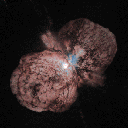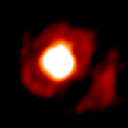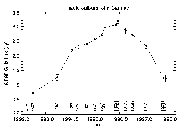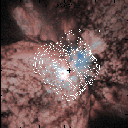




Eta Carinae is the most luminous star in our Galaxy (i.e., it puts out more energy than any other star we know of) and is therefore thought to be the heaviest star in the Galaxy, at roughly 100 times the mass of our Sun. The hot gas which was ejected in the 19th century now produces a beautiful visible nebula which surrounds the star and is known as the Homunculus nebula. The first image is a full-color Hubble Space Telescope image of the nebula and the star produced by Jon Morse and Kris Davidson. The second image is a radio picture obtained at a frequency of 5 GHz, and it shows much the same structures. The bright feature at the center of the radio image is where the star is: the emission here is effectively "burnt out", and it is shown in more detail in the last two images.
In recent years Eta Carinae has undergone a radio outburst which makes it one of the brightest radio stars in the sky. The third figure shows how the radio flux of Eta Carinae has varied with time since 1992. In 1996 Brasilian astronomer Augusto Damineli pointed out that there seemed to be a 5.5 year cycle in the emission from Eta Carinae, which he could clearly see in a particular emission line of the element Helium at infrared wavelengths. He predicted that Eta Carinae would show dramatic changes at the end of 1997, as it had in the middle of 1992. The radio data in this figure clearly seem to show that the radio flux has returned almost (but not quite) to the level at which we saw it in 1992 (coincidentally, the first radio observation was right at the previous dip in the cycle). Our most recent observation (February 1999) shows the radio flux to be on the increase again, with a morphology consistent with 5.5 years ago. A radio movie gives a graphic picture of how the radio emission changes. In a session at the January 1998 meeting of the American Astronomical Society, a number of observers showed other data confirming Damineli's prediction. More information on the recent research on Eta Carinae can be found on the web pages of Augusto Damineli, Mike Corcoran, and through links in the web page of Bish Ishibashi and Kris Davidson at the University of Minnesota. Damineli has shown that velocity shifts seen in some hydrogen lines imply that the star is actually a binary system composed of two massive stars, in a 5.5 year orbit around one another.
The increase in radio emission has occurred because cool gas close to the star, which in 1992 did not show up in the radio images, has been excited by a blast of radiation. We can see how this excited gas is distributed in the high resolution radio maps shown in the fourth image. In this image the left panels represent the actual emission at the epoch noted at the top of each panel, while the right hand panels show the change in the radio emission since the previous epoch. It is now believed that the system consists of two very massive stars, one of which is more evolved and has a powerful neutral wind, the other being a very hot star. The hot star supplies ultraviolet light which can ionize the gas in the system. However, when the evolved star passes between us and the hot star, its wind shuts off the supply of ionizing photons to the gas, which recombines (becomes neutral again) and thus ceases to emit radio waves. As the evolved star moves further on its orbit, the hot star is revealed once again and the process starts all over again. Thus the variation in the radio flux is due to a lighthouse effect, in which the evolved star with the strong wind controls the supply of ultraviolet photons from the hot star.
In the last panel we compare the radio emission (from April 1996) with the optical emission from the nebula by overlaying the radio map (white contours) on the HST optical image. The prominent ridge in the radio map running from the top left to bottom right corresponds to the "shoulder" of one of the lobes of the Homunculus nebula. The radio emission towards the upper right corner is in the direction of the red "paddle" noted in the optical image, but it does not extend as far as that. The cross marks the position of the radio peak at the time of minimum radio flux, in 1992 and 1998: from the radio point of view, this should be the location of the star.
Eta Carinae is in the southern constellation of Carina, where we look along one of the spiral arms which make up our Galaxy. The beautiful Carina nebula is shown in the "Miscellaneous" section of the Image Gallery.
All these images of Eta Carinae were made with the Australia Telescope , a radiotelescope near Narrabri in north-central New South Wales.